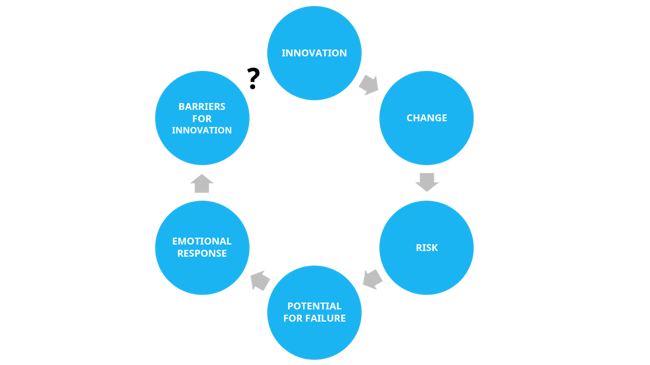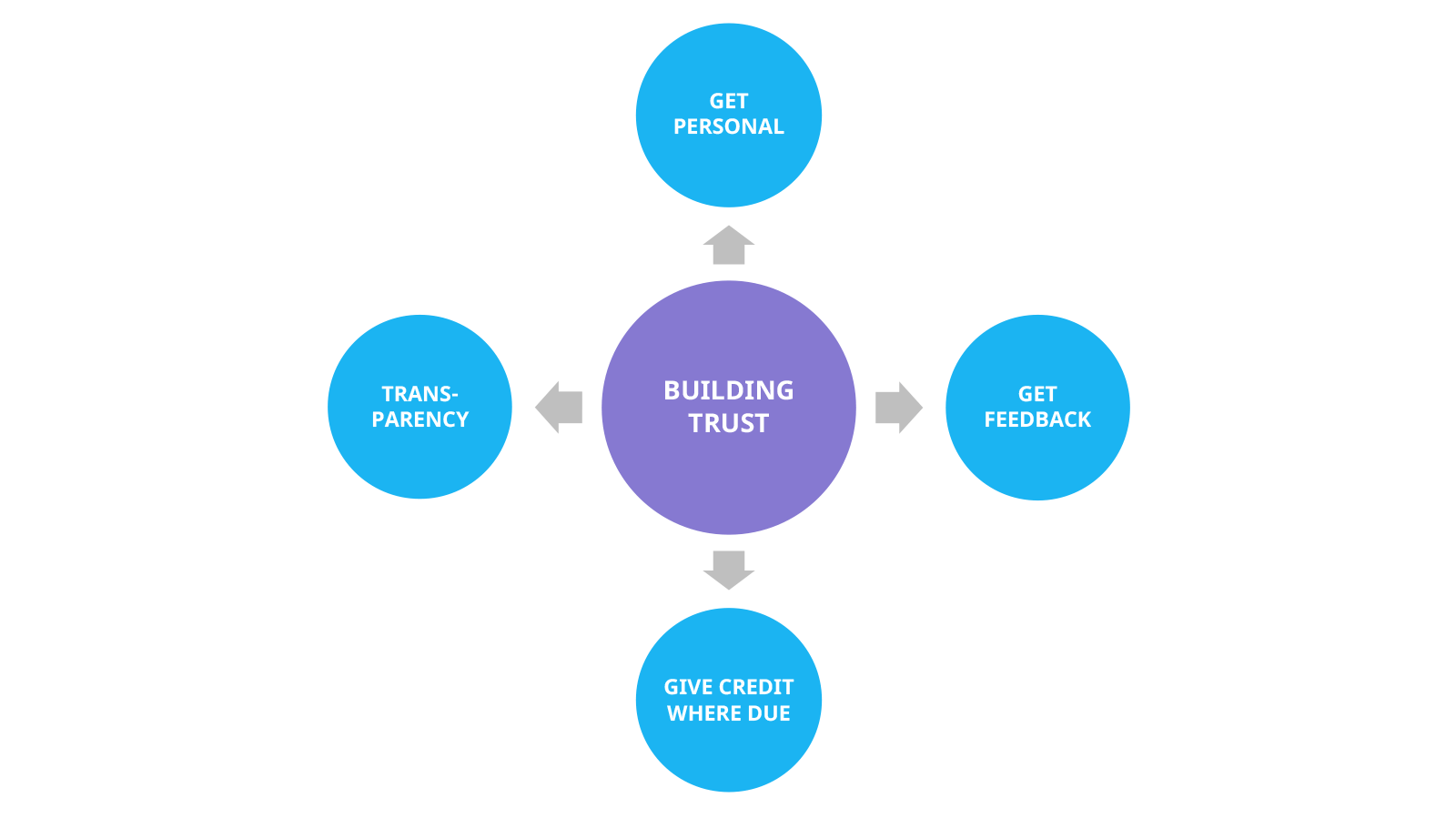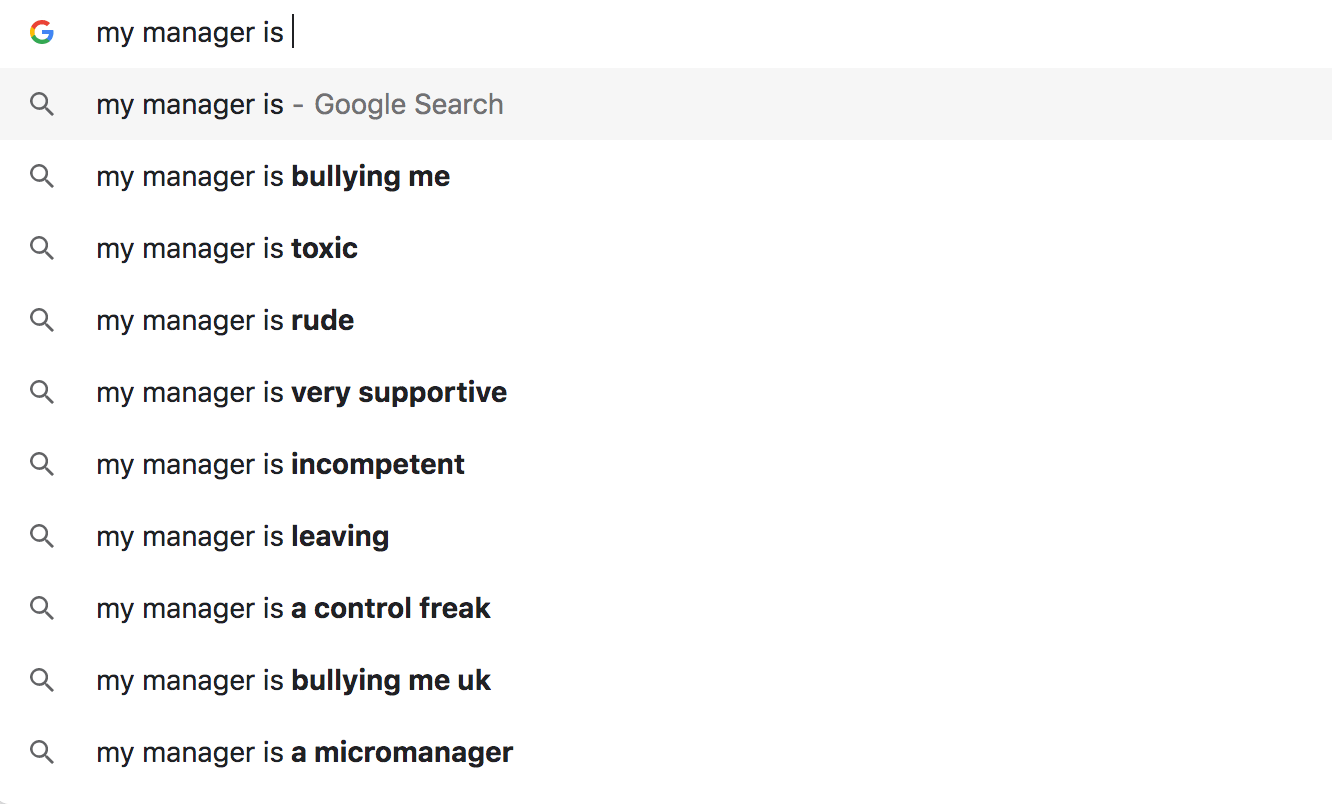Building Trust to Drive Innovation
You’re in leadership because you’ve excelled in prior roles and convinced a firm that you were the clear choice to move ahead, or you started the business. As a leader, your responsibilities catapult relentlessly forward, and it’s no longer just about you.
Whether at ten weeks or ten years, growing your teams’ capabilities is critical to maintaining relevance and growth. You need your team to elevate their skills to increase the chance of successfully navigating your firm through the myriad of challenges that will arise in whatever industry you’re operating. For this, you need to be leading a team that can innovate and aren’t afraid to create change.
During this evolution, you’ll need enormous buy-in from your team, and the most sustainable way to get them on that bus is through trust. They need to trust that they are safe exploring new opportunities and paths forward. Trust, safety, and innovation are inextricably tied together.
Your team needs to feel safe to embrace and own innovation. Why? Innovation brings change, change brings risk, risk brings the potential for failure and failure triggers a range of emotions that can stop or stall innovation.
According to a Harvard Business Review survey, 58% of employees trust a stranger more than their manager. There is progress to be made. So, where do you start building trust to drive innovation?

Table of contents
Trust Enables Growth
In 2016 as a Senior Vice President on Wall Street, a member of my sales team departed the firm, and I had a decision to make. The region was one of the smallest in the country. I could have replaced them with a new hire but given a variety of factors, I felt we needed a longer-term solution.
After not finding a reasonable candidate to replace him, a slow-down our business was experiencing and much research and analysis, I opted to dissolve the region. The initial plan was to reallocate the geography to adjacent team members, but I needed to work on the final details. I poured through the data and explored several options.
No matter what, this decision was going to have a significant lifestyle impact on one of my most tenured team members, requiring him to spend far more time on overnight trips. It was evident he was not going to be enthusiastic about any big change, but I needed to find a way to make it work, to make it feel like a safe choice.
What would you do? I called him.
– “Dave, I’m thinking about not replacing Jeff, and reallocating his region.”
– “Okay, what are you considering?”
– “Dave, you’ve been around here a long time and understand this geography far better than I do. I’d really like your views on how you think we could make this work best.”
– “What?” he said.
– “I’d like to hear your thoughts on how I should think about this change.”
– “Wow! Can you give me a few days to come up with a plan?”
– “Sure. Thanks for your help.”
The core decisions were largely made, but given his experience and thoughtfulness, and the pending disruption to his life, I genuinely wanted to gain his insights, but also needed his buy in. We met that Friday to go through his best-case scenario. His ideas overlapped about 80 percent with my existing proposal.
Both of our plans included a significant increase to his budget and the addition of another junior member to his team. Additionally, I made further changes to adjacent sales regions to make his one of the largest in the country. Dave was a little disappointed not getting exactly what he proposed, but at the same time he relished being part of the process.
The changes were now largely his, not mine. He had ownership. It wasn’t a perfect transition; that never happens. However, he was energized by the opportunity to have voice in the process and embraced the moment.
Inviting him into the decision made him feel safe to speak up, drew out his creativity, drove adoption and radically expanded his level of trust in me.
Inviting him into the decision made him feel safe to speak up, drew out his creativity, drove adoption and radically expanded his level of trust in me. He spent the next two years developing his skills, improving results in his new region, and soon found himself promoted.
This circumstance could have easily been one that I made the decision on and imposed upon him. He likely would have left, or worse yet, spent his free time working to damage the trust I had built with the rest of the team.
Instead, by empowering him to join me in the decision-making process, we not only landed on a better decision, but we grew trust between us, he found a promotion and other team members took note of my actions.
What Can Trust Do for You?
Gallup estimates that 70 percent of the variance in employee engagement is driven by managers.
Managers have enormous influence on their employees and their experience with the organization. The relationships they develop with their team members is critical and the level of trust they develop cannot be left to chance.
When trust is built intentionally, innovation can blossom in your business and deliver results. On the other hand, without a trust building strategy, innovation initiatives will struggle as employees won’t feel comfortable taking the necessary risks to drive change.
According to a Harvard Business Review article, “The Neuroscience of Trust”, when you trust your manager, the results are impressively clear. Employees are 76% more engaged, experience 40% less burnout and are 50% more productive. This leads to employees feeling empowered, initiatives more quickly adopted, mistakes by leaders given the benefit of the doubt, and team members twice as likely to stay with the company. Great Place to Work, a consultancy, found out that Fortune 100 Best Companies to Work For have delivered stock returns of nearly three-times greater than the market average. The common factor of these companies is a foundation anchored in trust. Trust enables innovation and drives results.
Great Place to Work, a consultancy, found out that Fortune 100 Best Companies to Work For have delivered stock returns of nearly three-times greater than the market average. The common factor of these companies is a foundation anchored in trust. Trust enables innovation and drives results.
According to Zenger and Folkman, the three key elements of trust are: Positive Relationships, Good Judgement/Expertise, and Consistency. What does this mean?
- Know your team members and their motivations; this isn’t a one-time event.
- Take time to consider the next steps for your business and utilize team input where appropriate.
- Reflect on and inquire about your internal brand.
- Finally, lead by example: exhibit behaviors that create a road map to success, never stop educating yourself, deliver on what you say, and be transparent along the journey with the plan.
Be vulnerable and let the team know you “want and need their input, as no one can make a perfect plan.
When your team trusts you, your views, and your relationship, you unleash their creative potential and enable them to reach new highs rather than work to avoid lows.
Why Do We Have Such a Dilemma with Trust?
Trust must be part of your leadership plan, and many times it simply isn’t. We often don’t have a map to lead us or as leaders feel comfortable executing a trust building plan, as it requires vulnerability, which can feel like a sign of weakness.
Additionally, building trust can appear complex and too distracting from hitting short term goals. So, other activities that appear to have priority end up filling calendars and building trust continues to be put on hold.
We can also get caught believing perks and a team outing for axe throwing will make up for our lack of focus on trust. Perks act like sugar for your body, they provide a quick spike in enthusiasm but quickly lose value, unlike relationships built on trust, that have an enduring impact on your team and company performance.
Without trust, fearful employees will work to protect their seats and leave growth for others to solve. You’ll know this has happened when innovators grow quiet at meetings and refresh their LinkedIn profiles, seeking new opportunities. Employee turnover is detrimental to any team, for morale and cost.
How Do You Build Trust and Enable Your Team to Grow?
“Building trust is a process. Trust results from consistent and predictable interaction over time.”
– Barbara M. White, First female to gain ambassadorial rank in the UN
With that background, let’s look at how building trust happens in practice. The image below illustrates the four key pillars for doing that. We’ll next cover each of them in brief.

Get Personal
Building trust does not happen with one email or by paying someone a compliment. It takes time and effort and is built by your actions, following your words. Your team needs to know what kind of person you are and what to expect from you in a variety of business climates.
Knowing each team member personally is the starting point to trust. They have to know you care and support them in their effort and that you know both their personal and professional situation. This will accelerate the building of trust and, more importantly, the understanding of what truly motivates them to take action.
At some point, you’ll be offering advice or coaching on how they can improve on something. If they don’t believe you know them, that conversation will take a long time to resonate, or it may never. Just because you’re their boss and said something doesn’t mean they will jump right in, even with trust. So, without trust, you’re simply delaying adoption or eliminating the chance of truly getting buy-in. It’s best to begin work with a new team by taking a listening tour, but it’s never too late to use this strategy. Let this tour be a part of your relationship-building effort.
It’s best to begin work with a new team by taking a listening tour, but it’s never too late to use this strategy. Let this tour be a part of your relationship-building effort.
Getting to know them on a personal level will open doors for this to work. Most people with children love to share stories about them. If you don’t know your employee has children, you’ll never understand the degree to which their family impacts their level of motivation.
Other questions to help you get started or to grow your relationship:
- What made you get into this industry?
- Tell me about yourself.
- Who’s been a great mentor in your career and why?
- What motivates you?
- Where do you like to vacation? Why?
The key here is to truly be curious as you dig deeper, and then capture these insights in writing. This will give you opportunities to better connect with your team members in the future.
At a semi-annual conference, one of my team members was celebrating a landmark birthday. As a leader with the firm, I had a suite reserved for me. Given it was his birthday, I borrowed an idea from our CEO, Arthur Steinmetz. I secretly traded rooms with the birthday boy and had a selection of his favorite craft beers and a birthday cake waiting for him when he arrived with a personalized note.
After he checked into his room, he sent me a text and asked me to stop by. He gave me a quick tour of his suite, showed me the gift basket, and told me “no one had ever done anything so thoughtful in my career.”
Financial rewards are always nice, but showing them you care and are listening to them is priceless.
Let Them Speak…and Listen
Gaining feedback from your team can be done more than one way, and is absolutely critical to building trust. It’s not just your team that needs to be curious, but also their leader. You need to be curious about your business and what’s on the minds of your team.
Before you think about engaging your team, consider this exercise from Dr. Tomas Chamorro-Premuzic. Open Google and type “my manager is…” and see what appears. Spoiler alert: most of it is not exactly positive. Do any sound like you?

Take time to reflect on the autocompletes that appear and fill in the blank yourself. This is a view of your internal brand and leadership style. When considering your brand, do these emotionally intelligent descriptors come to mind: trustworthy, empathetic, considerate, vulnerable, caring, and knowledgeable? How about “leader,” “manager,” or “boss?” Or does the Google search feel more on point?
“Your brand is what other people say about you when you’re not in the room.”
– Jeff Bezos, Founder & CEO of Amazon
Having a strong handle on your brand is paramount to building trusting relationships.
Take time to reflect on what you believe your personal brand is with your team and embrace this scary idea at least once each year. Solicit feedback from your team members directly, either face-to-face or by email, and act on it if you can.
If you can’t take action now, share why, thank them for their insight, and keep an “idea file,” noting the author for future use. Every idea your team comes up with won’t be viable, but you can keep them in a creative mode and hand-pick the best ideas to carry forward, large or small.
The Google search exercise can help you frame your questions, or you can start here:
- How have I been helpful in your career or role?
- How could I be more helpful?
- How could our team work more effectively toward our goals?
- How clear are our business objectives?
- What could I be doing better as our team leader?
Be prepared for answers you may not want to hear. This is how you grow. Great leaders do this regularly, and it gets easier over time.
The first time you ask these, the quality of answers will have a high correlation to that person’s perception of the relationship they have with you, a prior manager, or their comfort in job security. In feedback discussions, you need to capture insights, decide what to measure, and learn how it’s impacting your team. As you take action from feedback, announce what you’re doing with the team.
Give Credit Where Credit is Due
About one year into a leadership role with a remote team, I sensed the team wasn’t engaged enough in communicating and idea sharing. I asked a tenured team member, Bryan:
– “How can we better communicate as a remote team?”
– “Cut the number of conference calls we do!”
His response came so quickly, I wondered if he’d been waiting for this question his entire career. I quickly evaluated the entire year of calls and recognized we could easily eliminate almost 20 percent of them, largely by canceling calls that fell on holidays or internal conference weeks. I canceled call invites and announced a new pilot call schedule based on Bryan’s feedback.
This vulnerable act of asking for his advice quickly made him a supporter. Sometimes less is more when it comes to communicating. With fewer calls, engagement grew with less prompting from me.
At the end of the year, I asked the team, “Should we bring the calls back?” The silence was deafening. This didn’t preclude me from having occasional one-off calls. It did liberate several mornings on my team’s calendars, and, more importantly, let them know we were in this together.
This simple act was a turning point. The team took notice and new ideas began to appear from across the group.
Small changes that elevate a team member can have outsized results. The bar to build engagement on your team is lower than you think.
A full 25 percent of employees in the US feel outright ignored by their manager. Consistently giving your team a voice is powerful for building trust.
As a feedback loop becomes part of the process and you broadcast the changes made based on the feedback, you’ll find:
- Increased value in feedback and change you’re implementing.
- Personal brand growth as a trusted advisor.
- Future change easier to launch.
- Mission engagement takes a leap forward. Is the mission clear? Ask!
As my old manager Dave Robertson once said, “Good begets good.” Create a positive experience for team member contributions, promote the idea, and this will become contagious.
Transparency
“The best thing any leader can do to earn trust is to facilitate transparency.”
– Jeff Yurcisin, Zulily President/CEO”
Feedback and transparency go hand in hand.
David Gardner, Co-Founder of The Motley Fool (TMF) has creative ideas on sharing information. The company hosts biannual “campfire story” sessions. The term “campfire” is used very explicitly to set the tone for storytelling, not charts and graphs. They have veteran employees tell the history of the company, challenges they’ve faced, how they navigated them, and the outcome.
Employees don’t like to hear about layoffs and cost cutting, but through these stories they learn about the values of the company and gain a better understanding of how the next challenge will be addressed.
In addition to sharing stories, TMF regularly shares data on how the company is performing financially. They have scheduled “all hands” open-forum Q&A sessions throughout the year. These meetings capture a real-time sense of what’s on people’s minds, and they invite employees to challenge ideas. As Kara Chambers, VP of People Insights (HR), shared, “We are a company of investors, and our leaders are accountable to employees who are shareholders. People are not shy about sharing their views on internal decisions.” Keep in mind these employees are professionals that TMF hired because they’re amazing at analyzing other companies on their performance and decisions they’ve made.
As Kara Chambers, VP of People Insights (HR), shared, “We are a company of investors, and our leaders are accountable to employees who are shareholders. People are not shy about sharing their views on internal decisions.” Keep in mind these employees are professionals that TMF hired because they’re amazing at analyzing other companies on their performance and decisions they’ve made.
They scrutinize leadership decisions at TMF just as they would for a company’s stock they are considering recommending for their clients to buy. This is tight rope walking at best, but the way they’ve embraced this unique challenge with total transparency has helped them build an extraordinary business.
As you make decisions, your team wants to be in the loop and be a part of the process. Being transparent with what’s happening will bring greater clarity to where you’re headed. Explaining the “why” will further reveal your vulnerability and build confidence in you as a trusted leader, not just a boss.
Unsurprisingly, TMF has been named repeatedly on a variety of “best places to work” lists, such as the Washingtonian magazine and Business Insider.
Lead by Example
“There is something only a CEO can uniquely do, which is set the tone, which can then capture the soul of the collective.”
– Satya Nadella, CEO at Microsoft
“To build a culture of trust, lead by example,” Andrea Howe, founder of the Get Real Project, says. “You’ve got to be the trust that you want to see in the organization.”
Also point out when others exemplify the kind of behavior you do and don’t want to see. You can’t let poor behavior stand, but you also want to celebrate when someone does it right. This goes both ways. If your employee doesn’t feel you’re treating them well, they should be able to let you know.
Everyone you know has a story about not leading by example. Their manager (or parent) told them to do something and shortly after they discovered this was only a mandatory idea for one of you. Hypocrisy is not motivating. This will debilitate your current relationship and make building a future one difficult at best.
As a manager, you need to make people aware when they do something wrong, but you have to live by the same rules.
Celebrate Awesome
“Catch somebody doing something right and then acknowledge it in front of everybody else,” as Barron’s Top Advisor Patti Brennan put it. If she finds someone going above and beyond, she brings everyone into their conference room to announce the extraordinary behavior that same day. She announces what the person did, how it connects to driving business, and presents them with a small yet coveted trophy along with a one-hundred-dollar bill.
Imagine being in that presentation and the impression this moment leaves on you, especially if you’re a leader on her team. You’ll not only seek this glory, but as a leader, you’ll look for opportunities to celebrate your team members’ contributions. This strategy doesn’t just make people smile; it drives engagement.
In the US, 37 percent of employees feel their manager focuses on their strengths, and 61 percent of that group feels “engaged". Putting that into perspective, on average, 30 percent of US workers feel engaged in their jobs. The upside potential is strong. Enabling your team members is necessary for driving innovation, but they need to feel safe taking risks. Enablement is built on trusting you, feeling you know them, and that they have a voice. They need to know you approve of allocating time to finding a better way, and you need to lead by example.
Enabling your team members is necessary for driving innovation, but they need to feel safe taking risks. Enablement is built on trusting you, feeling you know them, and that they have a voice. They need to know you approve of allocating time to finding a better way, and you need to lead by example.
This is all part of becoming a trusted advisor to your team. The goal is creating a culture of innovation with a highly engaged team that seeks constant incremental change, optimization, and one that isn’t afraid to point out potential flaws in a plan. You’ll know trust has evolved when others gain the confidence to bring creative ideas forward that challenge your thinking, with and without prompting.
According to Paul Zak, the founding director of the Center for Neuroeconomics Studies, the benefits of trust at work include employees having 106 percent more energy and feeling 76 percent more engaged in their work.
Given the value of building trusting relationships, let's take an inventory of where your team is with trust.
The Trust Inventory
How can tell where you are with building trust with your team? Trust Inventory is a quick, simple and practical way to get a rough idea of this. You can take the free assessment I've created here: Is Your Team Innovation Ready?
The assessment should be done and reviewed by leaders at least annually, to develop and maintain a solid handle on the level of trust they’ve developed and to get a sense of how consistently their team is truly innovating.
If they’re not innovating, work with them to uncover specific areas they are struggling in. This is the work of a trusted advisor. Helping your team with problem definition, not problem solution.
As we've already covered, trust comes from having Positive Relationships, Good Judgement/Expertise, and Consistency. This assessment is built around these core concepts, my observations as a Wall Street leader and as business coach. It is designed to help leaders understand how their efforts are paying off and identify areas of growth for them, as well as opportunities for them to build trust.
With areas of specific focus, it’s easier for leaders to refine their business plans and calendars to ensure time is allocated to this important goal of trust building.
Conclusion
Trust is not easy to build. Without a high level of trust, the risk of driving innovation within your team is too high for most to take on. They will sit and wait for you or another colleague to take the lead. The ideal combination is a high level of trust with your team and a mindset of constant incremental growth that can ultimately lead to large scale growth as innovations evolve and more team members become engaged in the concept.
Leading innovation takes a proactive, intentional and thoughtful approach to trust building on your behalf. It needs to be a part of your regular activities. If you aren't seeing the innovation you want within your team, take time to reflect on these items.
First, your calendar activities. What activities are building trust and what could be delegated to free time for relationship building. Second, review your Trust Inventory score and take time to understand why it is where it is. Third, review how positive your relationships are with each team member, how you exhibit your expertise and the level of consistency you bring to each interaction with your team.
You still have to execute your job from day to day. However, shifting your mindset to think of employees, more like clients and allocating time each week to activities for trust and relationship building, ultimately you will create an environment of safety that enables your team to join the journey of growth and innovation you need them to embrace. This safe space unleashes the full talent of your team and energy to put into their work.
Enabling and empowering your team to innovate is the job of the leaders. Creating this mindset and culture in teams requires focus and planning. The change you need happens with thoughtful, proactive intentional work that unleashes your team. Let’s all move forward today.

Interested in Innovation and Leadership?
Subscribe to our blog to get the latest stories on innovation, leadership and culture straight to your inbox.






